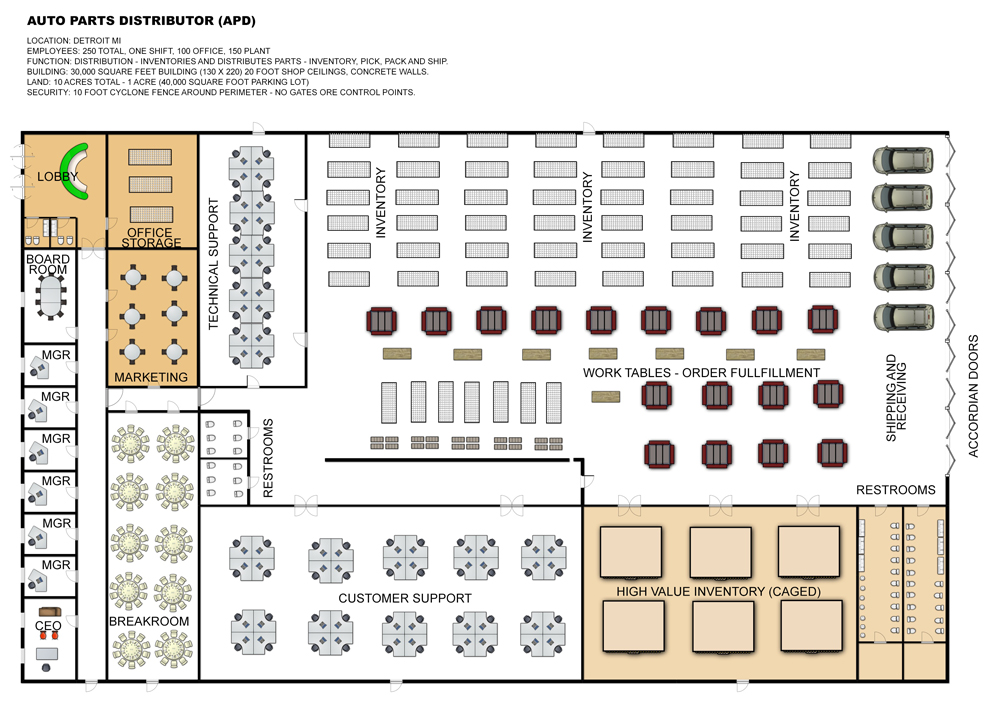Article Index
THE APD INC. SECURITY BRIEFING
Name: Auto Parts Distribution, Inc. (APD)
Industry: Automotive
Founded: 1910
Location: Detroit MI.
Revenue: $50 million
Employees: 250
Ownership: Private
Facilities: Single Building - 35,000 Square Feet

HISTORY
Auto Parts Distribution, Inc. (ADP) is a long established distributor of auto parts. ADP was founded in Detroit in 1910 and is still controlled by members of the founding family. The company remained in Detroit because of civic pride and deep roots in the community. Most of APD’s competitors, suppliers and customers have either moved south or offshore.
BUSINESS
APD distributes parts directly to auto manufacturers, to original equipment manufacturers (OEM’s) who incorporate APD parts into sub-assemblies and to retail stores located in the upper midwest. The company maintains a small fleet of vans that provide same day deliveries to customers in the Detroit area and also provide deliveries to retail store customers.
ADP maintains a large inventory of finished auto parts to service its customer base. Many of these parts are expense finished products ranging from tires to electronics and engine parts. The primary business function is picking, packing and shipping or delivering parts to customers.
There are three major groups of employees: laborers (150) who pick, pack, ship and deliver parts; customer service reps (50) who maintain daily phone contact with their customer base and management/adminstrative support personnel (50).

FACILITIES
The company operates out of a single building located in the I-94 Industrial Park Renaissance Zone. The location is in a high crime section of Detroit. The facility is a 1960’s vintage “tilt-up” single story structure made of concrete walls. The building is approximately 35,000 square feet in a simple rectangular layout. There is a 10 foot security fence enclosing the property although the entrance is not guarded or controlled.
The interior of the building is divided into three main areas - management and administrative offices, a call center and inventory/packing/shipping. All interior walls are drywall. The shipping floor is made up of rows of 20 foot high steel inventory racks, packing tables and two gated secure locations for high value inventory items.
The company maintains a small fleet of delivery vans which are parked inside the facility when not in use or after hours. Parking for employees is in front and along the sides of the building.
SECURITY ISSUES
The company is experiencing security threats on several fronts. The current Chairman/CEO has been under pressure by other family members to move or sell the business due to these escalating threats. A major security issue is inventory. The high dollar value of many of the parts, combined with how easy it is convert stolen auto parts into cash, combine to make the business an attractive target for thieves and other predators. Despite these escalating threats, the CEO is committed to staying in Detroit and will do what he needs to defend his business and employees. These are the major security issues he currently faces:
1. Random violence. The location of the company makes it an attractive target for opportunistic predators looking to steal cars, mug employees, assaults, rapes, etc. This violence takes place primarily in the parking lot and entrance to the company facilities.
2. Pilferage. There have been several instances in the recent past where employees were caught stealing inventory. Two had to be violently escorted from the premises.
3. Organized gangs. The company was recently attacked in broad daylight by gang members who ransacked the inventory and made off with tires, batteries, radios, flat screen monitors, etc.
4. Organized crime. The mafia in the past has attempted to use the business to “launder parts” from a network of “chop” shops in the city. They violently assaulted managers and family members attempting to convince them to do business.
5. Organized labor. The UAW has been trying to organize the shipping floor for many years. At times the organizing efforts have resulted in violence and there are rumors that union rats have infiltrated the company and are threatening and coercing employees.
6. Lack of police. Dwindling resources and the recent bankruptcy has significantly reduced the police presence and response time. It took the police two weeks to respond to the brazen daylight robbery.
7. Disgruntled employees. The company has a high turnover rate due to inconsistent work habits of many employees, and many of these with drug or other behavioral problems that impact their work effort. Several have become violent when terminated.
8. Inconsistent security. The company has used several local security guard firms, but none have been consistent in supplying capable guards and they have been ineffective in handling the security threats to date.
9. Insurance. The company’s insurance cost has sky-rocketed while covering significantly less in terms of losses and claims. The most crippling effect is a cap on inventory losses which limits the payout in situations of major theft or robbery. Inventory is the lifeblood of the company and they cannot function without having significantly more than the insurance cap allows. Which means that if a significant theft occurred the company and family would go bankrupt.
SCENARIOS
The company currently deals with these escalating threats by utilizing local security guard firms who typically supply 4 full time “guards” during working hours and 2 full time “guard” during “off” hours. This number will fluctuate depending upon time of year and circumstances. The company pays $35,000 a month on average for out-sourced security services.
The CEO and his management team are most concerned about the follow scenario threats:
1. Violent Assaults. Employees violently assaulted in the parking lot before and after shifts - primarily thefts but rape is also a concern.
2. Disgruntled Employee. A terminated employee returns with a weapon and opens fire.
3. Organized Theft. A local gang in concert with several locally owned auto parts “dealers” attempts to raid the facilities.
4. Civil Disturbance. Local residents rise up and start rioting due to lack of services, etc and threaten to loot and burn the facility.
VULNERABILITIES
Based upon the above descriptions APD can characterize it’s primary vulnerabilities as follows:
1. Premises. Employees and their property are vulnerable to theft and violent attack. There is currently no gate or controlled access onto the premises.
2. Inventory. The inventory is highly fungible and therefore an attractive target of petty theft, pilferage and organized criminals.
3. Financial. Inventory is the lifeblood of APD. Due to the actions of their bank and insurance company the very existence of the company is dependent upon defending this inventory.
MISSION BRIEF
Fred Schmitt decides to take his security in-house and form his own private security force. This is the brief he wrote describing the purpose of the new organization.
Name: APD Private Security (APDPS).
Mission: The mission of APDPS is to provide 24/7 security for the employees and facilities of Auto Parts Distributors Inc.
Strategy: Establish a new departmental function at APD called “Security” and staff it with trained employees who provide security as an extension of the current jobs.
Objectives:
1. Develop a cadre of highly-trained motivated employees to provide security.
2. Develop a comprehensive recurrent training program for APDPS.
3. Develop a comprehensive response plan by APDPS for these scenarios:
a. Violent assault.
b. Disgruntled employee - active shooter.
c. Organized theft.
d. Civil disturbance - riot, looting, arson.
4. Specify and purchase necessary weaponry, ammunition and accessories for APDPS.
5. Establish APDPS as a separate entity with proper licensing and insurance.
6. Extend basic firearms training to employees who want to conceal carry or learn basic firearms defense tactics.
7. Build a 4 lane 50 yard indoor range for security force and employee training.
8. Subsidize purchase of weapons and ammo for all employees not part of APDPS… $500 per year.
Since you have already listed and described threats, the next step is to grade each threat for probability (how likely is it to occur?) and consequence (how dangerous is it, if it does occur?). For each threat you have defined, assign an X value – how likely is this threat to materialize? – from 1 (highly improbable) to 5 (highly probable). Then assign a Y value – how serious would the consequences be? – from 1 (low consequence) to 5 (highest consequence).
Consider and grade each threat in turn. For instance, a takeover by a large armed foreign terrorist group that could put at risk your entire workforce would probably be one of your most dangerous threats – a “5”– but you may consider it highly unlikely if your business is like Fred Schmitt’s APD, distributing auto parts in Detroit. If you were constructing a threat assessment for a large synagogue in the suburbs of New York, you might consider such an event considerably more likely, but still less likely than a non-violent protest or a lone active shooter.
This is a subjective exercise, so it is advisable to undertake it in a group to minimize the effect of any one person’s biases. If you work through your list of threats with rigorous, deductive analysis, you will end up with a list of your threats graded something like this (An abbreviated list loosely based on our APD case study):
- Threat
- Brief description
- Probability
- Consequence
1. Armed group takeover Terrorist group, well-armed, politically motivated, with extensive planning and preparation.
- Probability: 1
- Consequence: 5
2. Nonviolent labor dispute. Union seeking to organize workers pickets the property, obstructing operations and intimidating workers, staff, customers.
- Probability: 4
- Consequence: 2
3. Lone active shooter. Disgruntled or psychologically disturbed former employee randomly or selectively targets personnel.
- Probability: 2
- Consequence: 4
4. Pilferage. Employee pilfers from company inventory or equipment for personal gain.
- Probability: 5
- Consequence: 1
5. Random violence outside. Individual or group assault on employee(s) outside building.
- Probability: 5
- Consequence: 4
6. Organized gang theft. Group attack to steal business property, inventory.
- Probability: 5
- Consequence: 3
The next step is to position each graded threat on your Threat Matrix graph.
EXHIBIT 3.2: APD Graded threat matrix.

Now you begin to have something actionable. Given that time and resources for addressing threats will always be limited, this Graded Threat approach gives you a basis for prioritizing your efforts. Threats in the More Likely/More Dangerous quadrant should receive early and sustained attention in your planning and resource allocation. The Less Likely/Less Dangerous quadrant contains threats to which you can confidently devote less effort. The other two quadrants require some careful analysis and decision making – are you more concerned over likelihood, or consequence?
Regardless of the degree of rigor you apply to your threat assessment, it needs to be updated at need – whenever significant information/intelligence with a high confidence level comes to your attention – and on a regular basis. Bring in trusted associates for every review, school them on your process if it is new to them, and let them bring a fresh perspective to the problem.




